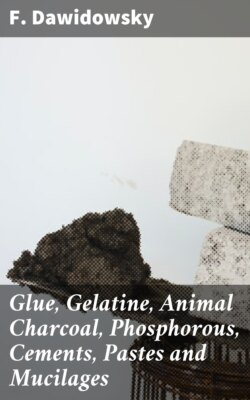Читать книгу Glue, Gelatine, Animal Charcoal, Phosphorous, Cements, Pastes and Mucilages - F. Dawidowsky - Страница 13
На сайте Литреса книга снята с продажи.
3. LEATHER WASTE.
ОглавлениеLeather tanned with a substance insoluble in water is not directly suitable for manufacturing glue, but can be made so by a special process, which, though somewhat tedious, nevertheless pays for the trouble.
In using such stock the manufacturer should make a distinction between old and new leather. The principal materials of this kind, large quantities of which contribute their quota to the glue-boiler’s stock, are old shoes, straps, harness, etc., and further, waste from shoemakers, trunk-makers, and in fact from the shops of all workers in leather except those using alumed leather.
Before boiling the leather waste to glue, the removal of all traces of tannin becomes absolutely necessary, since the retention of the smallest quantity prevents the animal tissue from dissolving in water.
The various methods proposed for the preparation of the leather waste differ either in the chemical solvent used, or in the mechanical manipulation of the waste.
The principal point in all methods is to comminute the waste as uniformly as possible to facilitate the complete removal of the tannin.
Various machines, some very complicated, have been proposed for the comminution of the waste, but a rag engine or “hollander” such as is used by paper-makers deserves preference for the purpose, as it not only comminutes, washes and prepares the waste in a suitable manner for the manufacture of glue, but the leather pulp when mixed with rags or woody fibre gives a substitute for leather which is very tough and of good appearance, and can be worked into many articles.
After the preparation in the hollander and careful washing the waste is treated, according to Stenhouse, under a pressure of two atmospheres in a boiler with water to which is added 15 per cent. of the quantity of waste to be treated at one time of slaked lime.
By another method the extraction of the tannin is effected by boiling the leather pulp with caustic soda of 1.025 specific gravity for from six to twelve hours. After drawing off the water and pressing out, the pulp is again boiled with caustic soda of the same concentration. The next process is to carefully wash out the soda, which is best effected in the hollander.
By neutralizing the soda lye in the fluid drawn off after the first boiling, it can be re-used for tanning or purposes for which tannin is required.
According to another method, the modus operandi is as follows:
Dissolve 1½ lbs. of oxalic acid in 3 gallons of water, pour the boiling solution over 110 lbs. of waste, and keep the mixture in a water-bath at a temperature of 176° to 212° F. This effects the solution of the pulp. Then dilute the solution by adding gradually 4 gallons of water until a uniform mass is formed. Now add 5 lbs. of lime slaked to a thin paste, and mix the whole thoroughly. The mass becomes friable and pulverulent. It is passed through a wire sieve and then exposed to the air. In three to four weeks the tannin is entirely destroyed, which is recognized by the mass assuming a lighter color. The lime is then removed by washing with water and hydrochloric acid. If the tannin has not been entirely destroyed by exposure to the air, add 1 lb. of liquid ammonia and a like quantity of pyrolusite to every 110 lbs. of leather substance when boiling it to glue. The oxygen yielded up by the pyrolusite, which, in the presence of ammonia, exerts no injurious effect upon the glue, destroys the last traces of tannin. Frequent stirring with a shovel while the material is exposed to the air and moderate heating, facilitates the destruction of the tannin.
